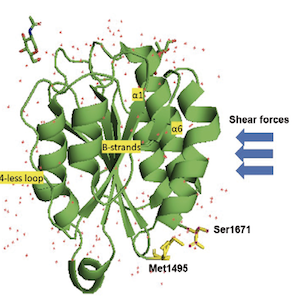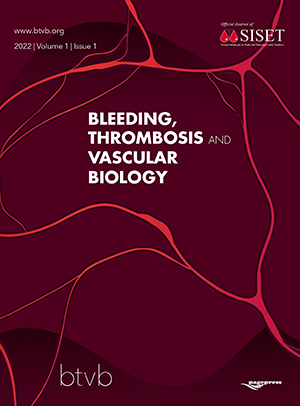Reviews
Vol. 1 No. 1 (2022)
The von Willebrand factor-ADAMTS-13 axis: a two-faced Janus in bleeding and thrombosis

Publisher's note
All claims expressed in this article are solely those of the authors and do not necessarily represent those of their affiliated organizations, or those of the publisher, the editors and the reviewers. Any product that may be evaluated in this article or claim that may be made by its manufacturer is not guaranteed or endorsed by the publisher.
All claims expressed in this article are solely those of the authors and do not necessarily represent those of their affiliated organizations, or those of the publisher, the editors and the reviewers. Any product that may be evaluated in this article or claim that may be made by its manufacturer is not guaranteed or endorsed by the publisher.
Received: 17 January 2022
Accepted: 1 April 2022
Accepted: 1 April 2022
2189
Views
397
Downloads
Similar Articles
- Pantep Angchaisuksiri, Wolfram Ruf, Jeffrey Weitz, Sam Schulman, Guy A. Young, A commitment to global collaboration, welcoming international participation and advancing science for the benefit of patients , Bleeding, Thrombosis and Vascular Biology: Vol. 4 No. 2 (2025)
- PO26 | Non-canonical coagulation platelets function: monocyte-platelet interaction a bridge between inflammation and coagulation , Bleeding, Thrombosis and Vascular Biology: Vol. 4 No. s1 (2025)
- Giovanni L. Tiscia, Donatella Colaizzo, Antonio De Laurenzo, Filomena Cappucci, Lucia Fischetti, Elena Chinni, Mario Mastroianno, Giovanni Favuzzi, Massimo Carella, Elvira Grandone, Thrombin generation assay in COVID-19 patients shows a hypocoagulable pattern , Bleeding, Thrombosis and Vascular Biology: Vol. 3 No. 3 (2024)
- PO43 | Extended treatment with reduced dose of direct oral anticoagulants in patients with venous thromboembolism: a retrospective study , Bleeding, Thrombosis and Vascular Biology: Vol. 4 No. s1 (2025)
- CO42 | Oxidative stress may contribute to enhanced thrombopoiesis through miR-150: implications for aspirin response , Bleeding, Thrombosis and Vascular Biology: Vol. 4 No. s1 (2025)
- PO44 | Emicizumab in acquired haemophilia A , Bleeding, Thrombosis and Vascular Biology: Vol. 4 No. s1 (2025)
- CO28 | Cognitive, adaptive abilities and behavioral symptoms in children and adolescents with hemophilia: a pilot study , Bleeding, Thrombosis and Vascular Biology: Vol. 4 No. s1 (2025)
- Francesca Santilli, Paola Simeone, Rossella Liani, Inflammation, platelets and diabetes , Bleeding, Thrombosis and Vascular Biology: Vol. 2 No. 2 (2023)
- Daniela Poli, Riccardo Tartaglia, Doris Barcellona , Paolo Bucciarelli , Antonio Ciampa, Elvira Grandone, Giuseppe Malcangi, Giuseppe Rescigno, Vincenzo Toschi, Sophie Testa, Alessandro Squizzato, Attitude to clinical research among health professionals affiliated with the Italian Federation of Centers for the Diagnosis of Thrombotic Disorders and the Surveillance of the Antithrombotic Therapies (FCSA) , Bleeding, Thrombosis and Vascular Biology: Vol. 2 No. 1 (2023)
- Domenico Prisco, Irene Mattioli, Raffaele De Caterina, Alessandra Bettiol, The new era of anticoagulation: factor XI and XII inhibitors , Bleeding, Thrombosis and Vascular Biology: Vol. 2 No. 2 (2023)
You may also start an advanced similarity search for this article.








